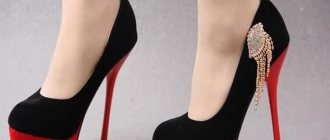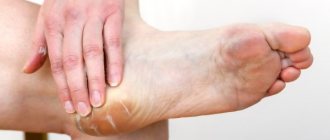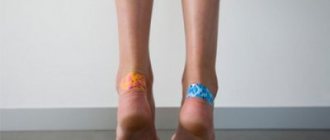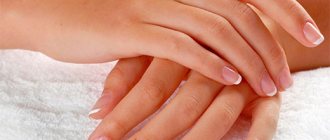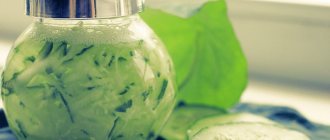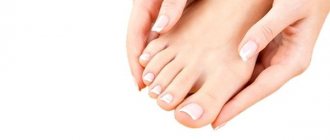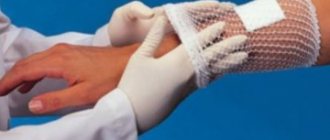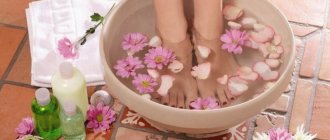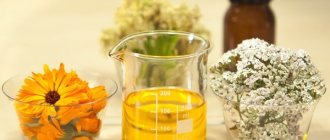How to get rid of calluses on feet | Home remedies for calluses and corns
Hello! Today I will tell you how to get rid of calluses on your feet. This is a problem that we often encounter, especially after breaking in new shoes. A callus is a cutaneous lesion that appears on the heel or toe area of the extremities. Typically, feet are injured due to friction or compression of the foot by uncomfortable (not the right size), narrow or rough shoes. Rubbing also appears from poor last shape, or from small grains of sand getting between the leather and the shoe material.
If the skin on your feet is damp, then any, even the most comfortable shoes will rub calluses. This nuance must be taken into account before putting on your shoes. Poor quality materials can also cause excessive sweating of the feet, which leads to the appearance of chafing, after which we begin to look for information on how to remove calluses on the toes or feet.
Treatment
There are three treatment options available at home:
- Use of medications.
- Mechanical impact.
- Use of traditional medicine.
Drug treatment
The following groups of drugs are used in the fight against calluses:
- Medicines containing salicylic acid. Regular use of such drugs allows you to remove the callus from its bed. Salicylic ointment is applied after taking a bath - on steamed but already dry skin. The active component of the ointment is aggressive, so you should avoid getting the drug on healthy areas of the skin (to do this, you need to cover the treated area with a band-aid). When the patch is removed, dead (keratinized) areas of skin are separated from the skin. The most famous preparations of the group: “Collomac”, cream “Namozol 911”, paste “5 days”, ointment “Nemozol”, cream Bottega Verde.
- Separately, it is worth mentioning such a means of combating calluses as Bensalitin ointment. This drug contains not only salicylic acid, but also benzoic acid. The ointment has an antiseptic and keratolytic effect.
- Preparations based on lactic acid. Compared to salicylic acid, lactic acid is less aggressive to the skin. The active substance softens the keratinized areas of the skin, after which they are peeled off using a cosmetic nail file and washing in warm water. Preparations containing lactic acid are applied to steamed, dry skin in a thick layer. Next, the feet are wrapped in wax paper and socks are put on. Drugs in this group include “Green Pharmacy” and “Super Antimozol”.
- Preparations containing celandine. The medicinal effect consists of cleansing the skin of keratinized layers, providing antimicrobial and anti-inflammatory effects. Before removing a callus on your toe, your feet need to be steamed. At home, you can use a plastic stick (or) match with cotton wool wrapped around it to apply the drug.
- Preparations containing sodium hydroxide. The active substance is an aggressive alkali that corrodes dead skin areas. The drug must be applied very carefully so as not to damage healthy skin. A special applicator is used for this. If the medicine is applied according to the instructions, the callus darkens, but no burning or pain occurs. After a couple of days, the destroyed tissue begins to fall off on its own. An example of a drug based on sodium hydroxide is the Antipapillom gel.
- Refrigerants. Such medicines have active ingredients called propellants. The therapeutic effect consists of influencing the callus with cold. As a result, the callus dries out and gradually peels off. Examples of refrigerants are Wartner and CryoPharma.
- Preparations based on phenol. The effect of phenol drugs is based on cauterization and mummification of tissue. The callus is treated with the drug and then dried in air. Over time, the pathological growth dies off. Phenolic drugs include “Verrukatsid”, “Vartek”, “Kondilin”.
Types of calluses and their differences
Calluses can be hard or soft; this is the main difference between them. Hard lesions cause discomfort and can usually be seen on the edges of the foot. A soft callus can develop on the toes, in the interdigital area, above the heel.
Soft calluses are very painful, hard skin lesions do not cause severe pain, but they are also uncomfortable and inconvenient. By the way, it is on rough calluses that cracking and splitting of the skin can appear; infection, bacteria, dirt penetrate through the cracks, which is even worse.
Very often, due to hard calluses, women's oversized tights quickly tear or fray during wear. With legs like these, you won’t be able to put on new tights without tightening them.
Why do calluses appear?
Calluses appear due to:
- poorly chosen shoes - poorly supported by the foot, pressing in certain areas;
- wearing high-heeled shoes for a long time;
- incorrect positioning of the foot while walking;
- long standing position;
- sports activities.
The occurrence of calluses is observed more often in people of mature age, this is due to the thinning of the skin against the background of age-related changes in the body. The skin is damaged on the growing bone of the big toe (bump on the side) as there is no natural cushioning.
There are also so-called symptomatic calluses, for example, with bursitis - a damaged joint of the thumb with curvature and protrusion.
Corn and its purpose
The nature of calluses is, in accordance with its own essence, elementary and highly functional. It is a protective reaction of the body and skin to any external factors or irritants. Fascinated by the masterful plucking of the guitar, we do not notice what the fingers of those who play the instrument look like. In reality, they are covered with real calluses. If not for them, then the skin would soon wear away to bloody wounds. The human body itself “took care” and built up a protective “armor”.
Recognizing the type of callus
To choose an effective treatment for corns and calluses on the feet, you should determine their type; a highly effective option will quickly solve the problem.
Calluses are divided into 5 categories. The formation can be very painful (coming into contact with the nerve roots during rubbing or pressure), or simply cause inconvenience.
- A hard callus is a common type (a small spot of rough tissue). There is a skin growth around the hard pea, which indicates wearing uncomfortable shoes or improper functioning of the foot joints while walking.
- Soft callus - formations appear most often in the interdigital area due to sweating or humidity. Such damage is whitish in color and resembles rubber when touched. Although the callus is called soft, it is dense inside, and if you press on it, pain is felt. Such formations appear when fingers that are too close touch each other (due to rubbing). Tight shoes provoke the appearance of soft calluses.
- A corn is a tiny callus, painless, that appears due to dry skin on the feet. Formations on the feet appear singly and in groups.
- Vascular (vascular) callus, dark purple in color (like dried blood), due to significant growth over some time, interferes with normal functioning in the capillaries of the upper tissues. The formations are painful and bleed when injured.
- Fibrous (fibrous) callus is a dangerous formation that appears due to untimely removal of ordinary calluses. The location is the upper layers of the skin, in close connection with collagen cells and tissues of the body. Such formations are deep, yellowish in color, sometimes very painful, and require professional therapy.
Once the type of growth is recognized, you can choose to treat calluses on your feet and toes and get rid of this problem.
Folk recipes
Treatment of calluses on the foot at home can be carried out using traditional medicine recipes.
For quick healing of wet calluses, aloe leaves should be used. To do this, you need to take a succulent leaf and cut it lengthwise, apply it to the wound, cover it with a piece of polyethylene on top and tie it with a bandage. This compress should be left for at least 12 hours. Complete healing occurs after 3-4 procedures.
Warmed pure propolis is applied to the affected skin after the legs have been thoroughly steamed. You should stick a patch on top or wrap your leg with a bandage. This mask should be left on for five days. After the compress is removed, the softened keratinized areas are removed with pumice. In just three procedures you can get rid of even the oldest and largest growths.
For the next recipe you will need to take a small onion and grate it on a fine grater. The resulting porridge is applied only to the affected area, avoiding contact with surrounding healthy tissue. The remaining onion must be removed after 2-3 hours.
Raw potatoes will also help get rid of old calluses. To do this, the vegetable must be grated and applied to the callus, wrapped with stretch film and a bandage on top. The compress must be left overnight, and in the morning the softened tissue must be removed using a stiff brush or pumice stone.
You can relieve inflammation from the skin with wet calluses using decoctions of medicinal herbs. Chamomile, string and plantain are best suited for this. To prepare the decoction, add 1 tablespoon of dry herb to a glass of hot water and boil for 15 minutes.
In the hot season, you can treat dry growths with the juice of fresh dandelion or celandine.
Calluses on the feet are a common problem that does not pose a threat to human health, but causes physical and mental discomfort.
How to treat a callus
You can remove a callus in different ways, for this there are:
- specialized restrictive gaskets made from foamed raw materials;
- plasters for removing calluses;
- medical options for removing growths using special tools;
- cosmetologist services (callus removal with a cutter, nitrogen treatment), drilling.
Hardware drilling is considered the most effective measure for removing calluses, since after such a procedure there will be no problems at all in this area.
Home remedies for calluses on feet
Most often, we are used to dealing with such problems on our own at home. And one of the effective remedies for removing calluses is sunflower oil. How to remove calluses with oil? In the evenings, for several days, after washing your feet before going to bed, you need to lubricate the problem area with oil and massage it. The growth will slowly soften, after which it can be removed with a pumice stone.
Treatment with propolis
A callus on a toe or foot can be treated with a bee product. To do this, make a cake from fat and propolis the size of the growth and place it on it. The procedure is carried out every evening before going to bed until the problem disappears.
Treatment of calluses with aspirin
Aspirin helps get rid of the problem - this is the best home remedy for calluses. Treatment can be carried out in any of the following ways:
- Steam your feet in a bath with a hot solution (2 liters of water, soda and sea salt). Dilute crushed aspirin (6 tablets) with one teaspoon of lemon juice. Mix both components until the consistency is homogeneous, apply the composition to the growth, cover with film, and put on a sock. Treatment of the callus lasts 20 minutes, after which remove the compress and clean off the formation with pumice. Lemon juice promotes softening, and aspirin delivers healing substances deep into the hardened tissue.
- Treatment of calluses with wrapping - stir aspirin powder (from 4 tablets) in a glass of heated water. Moisten a piece of gauze in the resulting solution, apply it to the calluses, put a film and a sock on top. Treatment time 1 hour.
- Treatment of calluses with a compress - before going to bed, wipe your steamed feet dry (for greater effectiveness), make a paste from crushed aspirin tablets and water. Apply the product to the callus, cover with cotton wool and an adhesive bandage for 12 hours. During this time, the growth will turn white and loosen, in this form it is easy to cut off. To remove the lower layers of the growth, repeat the procedure again.
Onion peel
Pour onion peels into a container, add vinegar to the top, close the lid, and leave in a dark room for 14 days. Separate the husk from the liquid, dry it, and apply it to the callus formation without affecting healthy tissue. To avoid accidental burns of the near-callous skin, it is better to lubricate it with Vaseline. Apply the compress before going to bed, remove it in the morning, and carefully scrape off the callus.
Lemons
For three evenings in a row, steam your feet and apply lemon peel with the pulp to the callus. After removing the compress, steam your feet again and remove the callus. It is better to soar your feet in herbal infusions. Some people dealt with calluses in this way, replacing lemon peel with bread crumb, previously soaked in table vinegar.
Garlic
Garlic gets rid of calluses in 2-3 applications. To do this, you just need to change compresses with garlic gruel three times a day. Apply the product so as not to touch healthy skin. In the same way, you can eliminate the problem with potato mush.
Calluses can be cured with dandelion milk or celandine (juice).
Is it possible to pierce a callus?
You can find different opinions on this issue. Some argue that a callus can be cured easier and faster by piercing it. Others are categorically against piercing.
It should be noted that the main danger of piercing a callus is that it creates an open wound that can easily become infected. Infection of the wound carries the risk of suppuration and inflammation of the heel tissue. In this case, the wound will have to be treated in the hospital.
If the callus is small and has just appeared, you should try to treat it without piercing first.
If the callus does not go away or it is unbearable to walk with it, you can try to pierce it. But this should be done very carefully!
So, first you need to prepare all the tools:
- Sterile needle;
- Scissors;
- Bandage;
- Sterile cotton swabs;
- Alcohol for disinfecting needles and scissors;
- Antiseptic (hydrogen peroxide, boric alcohol, brilliant green, furatsilin);
- Anti-inflammatory, healing ointment.
First, you need to thoroughly wash your hands and disinfect the needle and scissors with alcohol.
Then wipe the callus with a cotton swab and carefully open it with a needle. You should not hit with all your might directly into the middle of the callus! It is necessary to carefully pierce its edges a little in several places. Moisten a cotton swab with an antiseptic and press a little on the callus (very lightly), allowing the liquid to flow out. Then you quickly need to treat the resulting wound with hydrogen peroxide, boric alcohol or brilliant green.
There is no need to immediately cut off the skin from the wound; at first it will serve as a natural barrier against microbes.
How to treat a punctured callus
After treating the wound, a thin layer of anti-inflammatory antibacterial ointment must be applied to it. Well proven in this area:
- Levomikol;
- Iodopirone ointment;
- Furagel;
- Salicylic ointment.
Place a piece of sterile gauze or bandage on top (preferably rolled in 4-6 layers) and secure with a bandage or bandage.
Usually the dressing is changed once a day. At the same time, it is necessary to carefully monitor the degree of contamination of the bandage. If it leaks pus, the bandage must be changed immediately to prevent infection of the wound. After you have removed the previous bandage, and before applying a new one, be sure to clean the wound of any remaining ointment and disinfect it.
The following mixtures can be used as folk remedies for recovery:
- Warm honey lotion. Take two tablespoons of honey and heat it in a water bath for about five minutes. Moisten a bandage or gauze swab generously with the mixture and apply to the damaged area;
- Grate fresh beets and potatoes, apply the pulp to the wound and secure with a bandage;
- Mix 2 tablespoons of olive oil and one tablespoon of beeswax. Heat over low heat (just do not bring to a boil). Apply as lotions.
Honey is an excellent healing agent!
Applying the pulp of aloe or Kalanchoe to it will also help cure the callus.
During the treatment process, you need to carefully monitor the condition of the wound. Because if there is an infection, it can fester.
If you notice that the wound is festering, you should first apply a sterile cotton swab to it to remove the pus. Disinfect afterwards. Then apply one of the following to the damaged area:
- Iodinated ointment 1%;
- Levomekol;
- Miramistin 0.5%;
- Methyldioxylin.
Very effective and inexpensive anti-inflammatory, wound healing ointment
You can also try using folk remedies to treat suppuration, if it is not severe. For example, you can use lotions using rosehip decoction, sea buckthorn oil, lotions made from potato pulp, and beets. Rye bread is also famous among people for its good anti-purulent effect. Apply a piece of it to the wound and secure with a bandage.
However, it should be noted that folk remedies can only be used when the wound has just begun to fester. If after several procedures it does not get better, the damaged area begins to hurt, consult a doctor.
A few important rules
- Do not squeeze the callus with your hands;
- When piercing a callus, the needle must be held strictly perpendicular to the callus;
- If the bandages have dried to the wound, they should be moistened with warm, boiled water;
- Every time you change a dressing, be sure to disinfect the wound and wash your hands;
- Do not wear tight, tight shoes until the wound has completely healed.
Prevention of calluses
To avoid the appearance of uncomfortable and sometimes very painful calluses, you need to pay due attention to your feet:
Causes
Most often, any toe, heel or sole suffers from calluses; the skin on them is compressed and rubbed by uncomfortable shoes, for example:
- a pair made of low-quality materials, with roughly processed seams, excessively tight or, conversely, loose, with uncomfortable insoles;
- worn on bare feet or synthetic socks.
Calluses can be caused by the following reasons:
- overweight;
- profuse sweating;
- hormonal imbalance;
- professions associated with excessive stress on the feet (athletes, dancers, gymnasts often suffer from calluses);
- age-related changes (skin loses elasticity, dehydrates, dries);
- some diseases (arthritis, diabetes, vitamin deficiency, flat feet, gastrointestinal dysfunction, impaired blood flow in the legs).
When watery and dry calluses form, it hurts to walk and step on the soles. If left untreated, a bacterial infection develops. Pus accumulates in the blister. In this case, the pain not only makes movement difficult, it makes walking impossible.
The keratinized formations grow, involving healthy skin in the pathological process. A large growth is quite difficult to treat.
What to apply to a burst callus for quick healing?
A water callus is a skin formation that is a bubble of fluid that appears as a result of mechanical friction . It may be caused by tight shoes. Calluses form on the palms and fingers due to prolonged friction, for example, when working with any tool. The blister cannot be punctured or cut off , as this can lead to the development of a purulent infection and longer treatment. And in cases where the callus bursts on its own, it requires immediate treatment and taking the necessary measures to prevent further complications.
Treatment methods
Traditional treatment methods help cure a callus on the foot:
- Hardware technologies. Calluses and corns are quickly removed using pedicure devices. The cosmetologist treats the feet with a softening preparation and removes rough skin.
- Laser therapy. The laser quickly removes dead skin layers on the feet. After treatment with the beam, the skin becomes smooth and acquires elasticity. With the help of laser therapy, dry calluses can be cured permanently.
- Drug therapy. Ointments that can soften rough skin help remove calluses on the feet. The active ingredient of these drugs is salicylic or lactic acid. The drugs help exfoliate dead cells. Small dry corns are treated using anti-callus patches.
- Folk remedies help to cope with the problem. They are used in conjunction with medications, laser therapy and hardware methods.
Prevention
In order not to look for how to treat water calluses on the feet, it is best to take preventive measures. Simple recommendations that will protect you from blisters on your feet:
- Buy shoes that fit properly and are made from quality materials;
- Do not wear socks or tights with holes;
- Take care of your foot hygiene; if you sweat excessively, use special deodorants and powders;
- If you feel tension and heaviness in your legs, then eliminate the impact of the traumatic factor before the callus swells.
Dropsy is usually easily eliminated at home; it is very important not to let it become infected. If you notice the first signs of suppuration, you should immediately consult a doctor, he will explain how to treat water callus. Treatment is carried out not only in the hospital, but also at home.
It is very easy to rub calluses with new shoes, but few people manage to avoid this, unless, of course, the new shoes or boots were made to your own order.
Some ladies even deliberately buy shoes one size smaller so that their legs appear smaller than they actually are.
However, disappointment after such a purchase will not be long in coming: after walking only a few meters in new shoes, you will notice how much they rub and cause severe discomfort.
What to do if a completely new pair causes so many discomforts and problems, even when it was purchased according to size? How to treat calluses on feet from shoes that have already appeared?
Drug therapy
Medicines can quickly get rid of calluses on your feet. At home, problematic formations are treated using:
- Antimozolin. Lactic acid softens rough skin. Keratolin exfoliates dead cells. Plant extracts prevent the development of inflammation and do not allow healthy skin to be affected.
- Bensalitin. Salicylic acid, a substance that has a softening effect, helps get rid of corns. Feet, steamed in hot water, are treated with ointment.
- Medicine "5 days". The product is used to treat fresh calluses. It removes dead skin layers on the feet and prevents the formation of corns.
Ointments are used strictly following the instructions. If you violate the method of application, you may get burned. They refuse treatment if allergies occur.
Small calluses can be healed with an anti-callus patch . The product is impregnated with softening substances. A small piece that can cover the affected area is cut off from the patch and glued on. The keratinized cells slough off when the patch is removed. The use of this product is contraindicated if you are allergic to its components.
Treatment of calluses with traditional methods
Steaming the callus in a bath of warm water promotes rapid healing. For 3 liters you need to add 2 large spoons of baking soda and 1 - dried chamomile. Soak the foot in water for 10-15 minutes, spread it with Salicylic ointment, and seal it with a special plaster.
There are several ways to prevent the callus from becoming inflamed:
- Apply a cross-cut aloe leaf to the damaged area for 2-3 hours.
- Potato juice, which is applied as a lotion for 2 hours twice a day, relieves swelling, reduces pain and promotes healing.
- Propolis, added to baby cream in a ratio of 1:5, is applied to the wound, after which a bandage is applied. When using this method, an allergic reaction is possible, so during the first use you need to carefully monitor changes in skin condition.
Traditional treatment methods
At home, folk remedies are used to treat calluses on the sole of the foot. The formations are reduced with the help of compresses, foot baths, and ointments.
Compresses
Applications with herbal preparations soften keratinized calluses. Loose skin easily peels off from the lesions. To remove a callus from a child or adult, use:
- Onion feather applique. The arrows are cut into thin rings. Fix them with a bandage on the affected skin. The compress is applied before bedtime and left until the morning.
- An application of tomato paste prepared at home can help prevent calluses on the feet (commercially made ones are not suitable due to various additives). In the evening, the product is applied in a thick layer to the corns, covered with film, and insulated with a bandage. Remove the application in the morning, and wash off the remaining paste with water. Such compresses should be done daily until the callus disappears.
- Large callous formations can be treated with propolis . A piece of bee glue is frozen and grated. The crumb is applied to the callus, covered with film, and secured with a bandage. The compress placed in the evening is removed in the morning.
- Celandine gruel is an effective way to treat deep calluses. The leaves of the plant are crushed to a pulpy state. Apply the green mass to the hardened, old callus. Leave for 3-4 hours. After removing the application, the feet are washed.
- Prune application is an excellent folk method for getting rid of calluses. Dry seedless berries are simmered in milk and ground to a paste. Apply the warm mixture to the damaged area and leave until it cools. After removing the compress, wash the leg. Apply a fresh application. The total duration of the procedure is 30 minutes.
Foot baths
To eliminate calluses, take steam baths. Feet soar in warm water daily for 15-20 minutes. The feet are then treated with a nail file or pumice stone. At the end of the procedure, the feet are lubricated with a softening cream. Baths are used as the main method of treatment and a preparatory stage before applying pharmaceutical or homemade ointments that eliminate calluses.
Effectively fight corns:
- Soda baths. Add a tablespoon of tea soda, ammonia and soap shavings to 3 liters of hot water. For the procedure, use baby soap. Soak your feet in the solution for 30 minutes. The rough layers of skin are cleaned off with pumice. The treatment will give a better result if the water is replaced with whey from yogurt.
- Coniferous baths. Extract from spruce and pine buds softens and disinfects the skin. Place a teaspoon of kidneys in 1 liter of water, bring to a boil, and simmer for 3 minutes.
- Potassium permanganate is a wonderful way to remove calluses. A deep pink solution is made from potassium permanganate.
- Salt baths are a good method for getting rid of corns. Dissolve 3 tablespoons of salt (edible/sea) in 3 liters of hot water.
If your foot has suffered from calluses, ointments are prepared at home. Preparations are made using the following recipes:
- Ointment with potatoes and flax seeds is an effective treatment for calluses. Take 100 g of potato peel and 2 tablespoons of flaxseed, add a small amount of water. Simmer on fire for 30 minutes. A thick paste is applied to the sore spot. After half an hour, the application is removed.
- Garlic ointment relieves corns. The head of garlic is baked and combined with the same amount of butter. First, the sore foot is steamed in a bath. After this, the corns should be rubbed with garlic ointment, covered with a leaf of burdock or cabbage, and insulated with a bandage. The leg will heal in 4-5 days if the compress is applied 3 times daily with an interval of 4 hours.
- Calluses quickly disappear if you rub them with ointment containing pork fat. Combine 50 g of fat with 2 tablespoons of gruel obtained from freshly harvested celandine (or dry powder). The composition is placed in a water bath, heated to 50 0 C. Before going to bed, the product is applied in a thick layer to the callus formation and left until the morning.
How to quickly cure a callus on the leg, foot and other parts of the body
Treatment of calluses on the leg and other parts of the body depends on its type; each type of callus needs to be treated in its own way. General recommendations for the treatment of calluses include:
Finding and eliminating the cause of calluses (for example, changing shoes, or taking special vitamins that can strengthen the skin, etc.)
Bandaging the damaged area, or using a special antibacterial patch.
How to quickly treat wet and soft calluses
Treatment for dropsy is quite simple and inexpensive.
Treatment of calluses should be done with an antiseptic solution. If removing a callus involves piercing it, it should be done with a clean needle. You cannot pierce the callus from above; the puncture should be made from the side, it is less painful and safer, because When making a puncture from above, there is a possibility that the callus will become inflamed because Irritation may occur; it is better not to touch the source. The dressing needs to be changed twice a day, and the former callus should be treated like a wound. If the dropsy bursts spontaneously, do all the same steps (except for puncture with a needle) and do not forget to clean the wound.
What not to do with a callus:
- You cannot cut off the top layer of callus yourself with a knife or other means. The peel is needed to prevent germs and infections from entering the wound.
- It is not advisable to use an adhesive plaster on a swollen, unbroken callus.
Treatment of soft calluses with folk remedies
A liter of warm water per spoon of table salt makes an excellent foot bath. You should not keep your feet in the solution for a long time. The same can be done with potassium permanganate. Herbal baths help well: calendula, chamomile.
To make the wound after a callus heal faster, you can anoint it with tomato juice, or apply a well-crushed aloe leaf, and use an adhesive plaster on top. The same can be done with horse sorrel.
The combination of vegetable oil and tea tree (one to three) protects against infections and accelerates healing. The composition must be applied four times a day.
Tampons made from potato pulp applied to the damaged area will remove dropsy within a few days. The bandage with the pulp should be changed once a day.
You can apply Kalanchoe leaves to calluses. The foot should be dry and steamed after the bath.
Pharmacy products for the treatment of soft calluses
The choice in the case of water calluses is quite large. The most popular adhesive plasters used for painful sensations are Compeed (Johnson & Johnson). This patch absorbs the secreted fluid, does not interfere with movement, and creates an environment in which the wound can heal faster.
Scholl. Another type of adhesive plasters, they do not allow air to pass through, but also germs. The advantage of such adhesive plasters is that they contain hydrogel.
Ointments for calluses also have a number of advantages. Most Popular:
- Pasta “Five days”. Costs on average about 50 rubles, has a healing and softening effect. Suitable for absolutely any skin type.
- Ichthyol ointment softens the skin, relieves inflammation, and relieves pain. It is easy to find in any pharmacy, the price on average is about 60 rubles.
- Vitaon ointment. Suitable for small watery calluses. Effective against small wounds. The base is olive oil. The drug itself is herbal and can only harm people with allergies. Generally harmless and suitable for small children. Natural composition and price from 450 rubles.
- Zinc paste. Widely used for completely different skin diseases, including the appearance of calluses. It has a drying effect, but it is contraindicated to apply to large wet calluses; it is perfect for small blisters. It is recommended to apply only at night. The price is 50 rubles.
How to quickly treat dry and core calluses
The treatment for such calluses is to gradually scrape off the dead skin. Most often, pumice is used for this. You need to scrape off the epidermis after your feet have steamed in the bath, or simply after a regular bath. This may cause some pain, but in the future it will bring noticeable relief when walking. After scraping, it is better to keep your feet warm; it is recommended to wear warm socks.
It is best to have a professional do the scraping. For example, a surgeon, dermatologist or other attending physician. Since during treatment, a solution of salicylic acid is used to soften the callus and remove it, and special tools are used to remove the root of the callus (core).
Treatment methods for callus:
- Cryotherapy. The doctor uses liquid nitrogen to destroy the callus. Not a very pleasant way, but effective.
- Laser therapy. The doctor cauterizes the calluses with a laser, a painless and very quick procedure.
- Drilling. Using a special device, the doctor makes small indentations in the skin and pours special medications into them, including anti-inflammatory ones.
Softening of the callus should take three days with a break of one or more days, depending on the results, because it may damage the skin.
A suitable doctor can advise and select special insoles and make recommendations regarding shoes.
Acids that soften the skin:
- dairy;
- salicylic;
- carbolic
Pharmacy products
If you still remove hard calluses at home, you can use Super Antimozolin, Bensalitin, and Lekker-Stopmosol ointments. They soften the callus and apply directly to it.
The list of pharmaceutical products also includes salicylic ointment; it reduces the possibility of infection and its development, and has an anti-inflammatory and softening effect. Contraindicated for young children, people with liver failure and severe kidney disease.
Price: from 70 rubles.
Levomekol ointment helps in cases of suppuration and infection of the callus. The average price is 120 rubles. For old calluses, you can use Bensalitin ointment. Treatment usually lasts about ten days.
Costs on average seventy rubles and more.
Sophia cream relieves corns and old dry calluses, reduces pain and reduces the risk of scarring.
The cost is 250 rubles.
General methods of treating calluses with folk remedies
There are many folk remedies that can help eliminate calluses.
- Onion. An ordinary onion, cut in half (or crushed into pulp), is applied to the site of damage. The main thing is not to burn healthy skin. You should not keep the onion lotion for a long time.
- If you apply a compress of bread crumb moistened with a bite to an old callus for eight days, then it can be easily and completely painlessly removed.
- Common dandelion juice is used to lubricate calluses; after a few days they disappear.
- Juice or gruel from figs on steamed legs after a bath gives a healing and anti-inflammatory effect.
- Burdock gruel in the form of lotions is also very effective; it disinfects wounds.
- Onion and vinegar lotions are a quick solution for calluses. The onion needs to be divided in half and thoroughly soaked in vinegar; you can even pour the vinegar into a container and then throw the onion halves in there. After they are properly soaked, use the onion leaf as a lotion and change it often along with the bandage.
